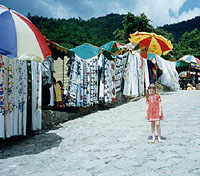|
On average, the Wall is 24 feet high and 18 feet wide. In some places it is said to be wider -- wide enough for 8 horses to stand side by side.
The Great Wall has not always been great. Centuries ago it began as a series of much shorter walls, each constructed by various State and Provincial leaders as a defensive boundary. Then, during the Qin Dynasty, the Great Emperor, Qinshihuang, decided to unite China. As part of his effort, in 221 BC, he commanded that all of the smaller walls would be joined together to form one Great Wall.
It took thousands of men and hundreds of years.. Building the Wall was no small matter. The king's soldiers were poised to watch over the laborers who were, for the most part, forced to work on the construction teams. It was said that this duty station was considered the least desired of any in the military. The enslaved workers didn't care for their work and often attempted to escape. When they were ultimately captured in the rugged country, they were buried alive within cavities in the Wall and left to starve or suffocate. This cruel punishment was done to set a firm example to other workers. This earned the Wall the epithet, "The Wall of men's bodies and women's tears."
Legend has it that, within three days after his marriage, a poor peasant man was conscripted to begin working on the Wall by the Emperor . His new bride was heartbroken and grief stricken. She decided that, after a time, she would try to visit with him. After much hardship, the bride arrived at the section where her husband had been sent to work, only to learn that he had recently died. Grief stricken, she stumbled to the base of the Wall and began crying. Suddenly the Wall began to shake, as if an earthquake had struck, and the portion of the wall near the bride crumbled. There, in the dust and rubble, were the remains of her husband. He had obviously attempted to escape, and failed. She gave him a proper burial and today there is a commemorative shrine on that spot.
This day as we stood on the wall and looked at the colorful backdrop of blue sky and lush green foliage, it was hard to imagine such ugliness.
Among the supplies kept in these buildings was fuel for fires. Communication was a strategic essential for soldiers along the wall. Without the benefit of electricity or radios, ancient soldiers communicated visually with fires and cannon blasts. Such signals were be sent by line-of-sight to stations far on the horizon. It was actually quite efficient and rapidly allowed ample warnings to concentrate troops at areas of invasion.
Oddly, the fires were built of straw, sulfur and wolf dung. One fire and one cannon blast signaled an invasion of 1000 soldiers or less. Additional blasts and fires meant larger invading forces with five, the maximum, representing an invading force of 10,000 troops.
We gathered together and strolled back to where we had first entered the Wall. There we found Tristan, my son, who was still sitting on the steps, not liking the height of the Wall. He had been kept amused by watching the local squirrels jumping and bouncing off the wall.
Our adventure was not over yet. On the road leading down from the tram station we noticed that lots of little booths with round tables had been set up, filled with items for sale to tourists from all over the globe.. They had everything from Cloissin Jewelry to wooden carvings, T-shirts and quilts. All beautifully hand made with the attention to color and detail that is so Chinese.
The troopers among us all brought themselves a hard earned "I Climbed The Wall" T-shirt. They don't make "I sat on the Wall" T-shirts so I had to buy quilts instead.
A few days following our trip to the Great Wall, I had need to do some shopping near our home. The Chinese are ferocious bargainers. A natural born chicken, I tend to surround myself with someone brave -- my husband, or Song Ye Yun (our helper). As they were busy with their own shopping, I had no one to protect me from the "attack of the vendors!" I was faced with either running through the deluge to escape them, or stand my ground and confront them. I really needed to shop so I buried my fears, and, armed with my few words of Chinese, did battle with a circle of Chinese women, all yelling their prices at me. I found myself yelling back my offer and began to feel the exhilaration of the bargaining process. I had felt powerful and "in control!"
The Chinese are a very ancient and enduring people. They have had to deal with much hardship in the past, and it is still present in their lives today. I always wondered how they kept going in face of such adversity. Maybe it was the spirit of The Great Wall? Maybe it was the thought of all the men and women who labored and suffered to make the Wall. They know that, together, they can endure anything. My exhilaration perhaps came from my better understanding of their pride and endurance and the way in which their zest for life is applied to even routine tasks like shopping in the market. 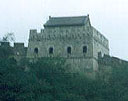 |
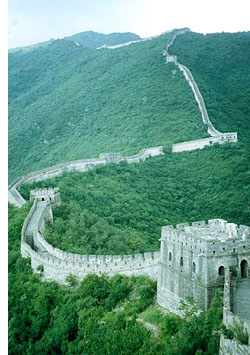 At the top, when we could look inside the Wall, we learned that it isn't one wall at all, but actually two! The inside of the two parallel walls has been built up with a foundation of sand, pebbles and rock. It is then paved with flat stones to form an elevated road that runs the length of the Wall. How long is that? Enough wall to stretch easily from New York City to Los Angeles! That's 10,000 Li, 5,000 kilometers, or 3,100 miles.
At the top, when we could look inside the Wall, we learned that it isn't one wall at all, but actually two! The inside of the two parallel walls has been built up with a foundation of sand, pebbles and rock. It is then paved with flat stones to form an elevated road that runs the length of the Wall. How long is that? Enough wall to stretch easily from New York City to Los Angeles! That's 10,000 Li, 5,000 kilometers, or 3,100 miles. 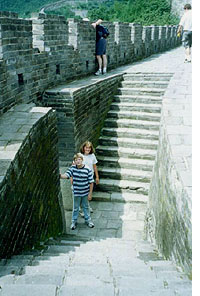 My oldest son, Tristan, was fearful of the height of the Wall and, after we managed to get him walking for a bit, he decided to forego the hike to the summit and rest on some stairs that led to an outside doorway at the bottom of the Wall. He seemed safe and content, so we continued our trek.
My oldest son, Tristan, was fearful of the height of the Wall and, after we managed to get him walking for a bit, he decided to forego the hike to the summit and rest on some stairs that led to an outside doorway at the bottom of the Wall. He seemed safe and content, so we continued our trek.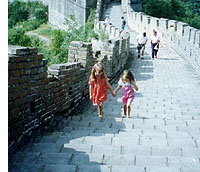 The children were running around, happy and laughing. The adults were following leisurely behind and having a pleasant chat. We soon came to a beacon tower and what looked like a guard house. While the children played "hide and seek," Sharlet and I tried to envision the horses being kept here or the soldiers climbing the stairs and looking to the distant horizons for invading armies.
The children were running around, happy and laughing. The adults were following leisurely behind and having a pleasant chat. We soon came to a beacon tower and what looked like a guard house. While the children played "hide and seek," Sharlet and I tried to envision the horses being kept here or the soldiers climbing the stairs and looking to the distant horizons for invading armies.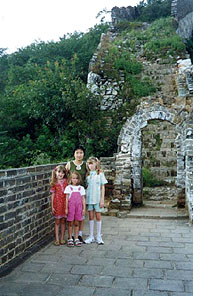 Beyond the guard house, some of the adults sat on the steps to rest while the heartier adults and kids hiked all the way to the "end" of the Wall. The Wall itself continues, but the unrestored sections are quickly taken over by grass and vegetation and are not even passable.
Beyond the guard house, some of the adults sat on the steps to rest while the heartier adults and kids hiked all the way to the "end" of the Wall. The Wall itself continues, but the unrestored sections are quickly taken over by grass and vegetation and are not even passable.